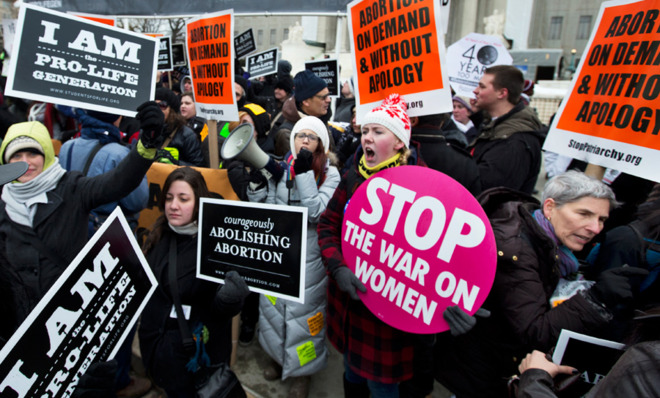How abortion emerged as the GOP's favorite wedge issue
The culture wars are back


The Supreme Court on Monday declined to hear an appeal of a decision striking down Arizona's 20-week abortion ban, delivering a victory for reproductive rights advocates who had argued that the ban was a blatant attempt to chip away at Roe v. Wade.
In opting not to hear the case, the high court sidestepped an opportunity to address similar laws that have popped up elsewhere around the country in the past few years. Indeed, the mere fact that such a case came to the justices' attention in the first place underscored how Republican lawmakers, at both the state and federal level, have redoubled their efforts to restrict abortion access.
Last year alone, 22 states passed 70 new provisions that in some way restricted abortion access, the second-highest annual total ever, according to the Guttmacher Institute. That was up from 43 such measures the year before, and in the same ballpark as the record 83 restrictive provisions passed in 2011.
The Week
Escape your echo chamber. Get the facts behind the news, plus analysis from multiple perspectives.

Sign up for The Week's Free Newsletters
From our morning news briefing to a weekly Good News Newsletter, get the best of The Week delivered directly to your inbox.
From our morning news briefing to a weekly Good News Newsletter, get the best of The Week delivered directly to your inbox.
All told, states enacted more abortions restrictions in the last three years than in the previous 10 combined.
The surge can be traced back to the 2010 elections, when the GOP won big in state legislatures around the country. Heading into that election, the GOP controlled the entire legislature in 14 states; after the election, they had full control in 25, the most in almost six decades.
With those newfound majorities, Republican lawmakers set about pushing through a GOP wish list of changes. Several states immediately sought to curb the power of public employee unions, pass voter ID laws, or ban gay marriage. Restricting abortion access was another top priority.
As a result, a dozen states, including Arizona, passed bans on abortion beyond 20 weeks of pregnancy. Others imposed strict new standards for abortion clinics and the doctors who perform such procedures. In Texas, critics contend that a highly controversial law could force up to a third of the state's abortion clinics to close.
A free daily email with the biggest news stories of the day – and the best features from TheWeek.com
At the national level, too, Republicans turned their attention to abortion following the 2010 midterms, which resulted in the GOP retaking the House. Driving the issue was the Tea Party.
Tea Partiers, despite their libertarian leanings, nonetheless support abortion restrictions, and their vocal presence prodded GOPers to take up the issue. As a result, the House sought to yank Planned Parenthood's funding amid a broader debate about curtailing government spending.
The anti-abortion push got a shot in the arm in May 2013 when Dr. Kermit Gosnell, a doctor whose abortion clinic was dubbed the "House of Horrors" for its gruesome practices, was found guilty of 237 crimes, including three counts of first-degree murder. Republicans held up Gosnell as representative of abortion in general, both decrying the perceived lack of media attention to the story and Gosnell's crimes itself to argue for a renewed effort to restrict abortions.
"Now is the time to step up and act," Republican National Committee Chairman Reince Priebus said following the ruling. "There will likely be abortion advocates who denounce these leaders. These are the voices that reject any talk of regulating abortion, but they have no ground to stand on here. There is no defending Kermit Gosnell or the broken system that enabled him."
One month later, the House approved a 22-week abortion ban based on the disputed theory that fetuses at that stage of development can feel pain. Supreme Court precedent has traditionally set the threshold for abortions at 24 weeks.
The renewed focus on abortion is not without its dangers for the GOP. Democrats effectively framed efforts to curtail abortion access as a "war on women" in 2012. (Remember Todd Akin?) And, as Texas gubernatorial candidate Wendy Davis (D) showed, abortion can energize the Left, too.
The GOP concluded after the 2012 election that it needed to soften its image to attract a wider swath of voters. But as the House GOP's 2014 agenda indicates, the party's rank and file aren't too keen on heeding that advice.
Jon Terbush is an associate editor at TheWeek.com covering politics, sports, and other things he finds interesting. He has previously written for Talking Points Memo, Raw Story, and Business Insider.
-
 11 extra-special holiday gifts for everyone on your list
11 extra-special holiday gifts for everyone on your listThe Week Recommends Jingle their bells with the right present
-
 ‘Furious Minds: The Making of the MAGA New Right’ by Laura K. Field and ‘The Dream Factory: London’s First Playhouse and the Making of William Shakespeare’ by Daniel Swift
‘Furious Minds: The Making of the MAGA New Right’ by Laura K. Field and ‘The Dream Factory: London’s First Playhouse and the Making of William Shakespeare’ by Daniel SwiftFeature An insider’s POV on the GOP and the untold story of Shakespeare’s first theater
-
 How to shop smarter with a grocery budget
How to shop smarter with a grocery budgetThe Explainer No more pushing your cart down the aisles on autopilot
-
 Has Zohran Mamdani shown the Democrats how to win again?
Has Zohran Mamdani shown the Democrats how to win again?Today’s Big Question New York City mayoral election touted as victory for left-wing populists but moderate centrist wins elsewhere present more complex path for Democratic Party
-
 Millions turn out for anti-Trump ‘No Kings’ rallies
Millions turn out for anti-Trump ‘No Kings’ ralliesSpeed Read An estimated 7 million people participated, 2 million more than at the first ‘No Kings’ protest in June
-
 Ghislaine Maxwell: angling for a Trump pardon
Ghislaine Maxwell: angling for a Trump pardonTalking Point Convicted sex trafficker's testimony could shed new light on president's links to Jeffrey Epstein
-
 The last words and final moments of 40 presidents
The last words and final moments of 40 presidentsThe Explainer Some are eloquent quotes worthy of the holders of the highest office in the nation, and others... aren't
-
 The JFK files: the truth at last?
The JFK files: the truth at last?In The Spotlight More than 64,000 previously classified documents relating the 1963 assassination of John F. Kennedy have been released by the Trump administration
-
 'Seriously, not literally': how should the world take Donald Trump?
'Seriously, not literally': how should the world take Donald Trump?Today's big question White House rhetoric and reality look likely to become increasingly blurred
-
 Will Trump's 'madman' strategy pay off?
Will Trump's 'madman' strategy pay off?Today's Big Question Incoming US president likes to seem unpredictable but, this time round, world leaders could be wise to his playbook
-
 Democrats vs. Republicans: who are US billionaires backing?
Democrats vs. Republicans: who are US billionaires backing?The Explainer Younger tech titans join 'boys' club throwing money and support' behind President Trump, while older plutocrats quietly rebuke new administration
